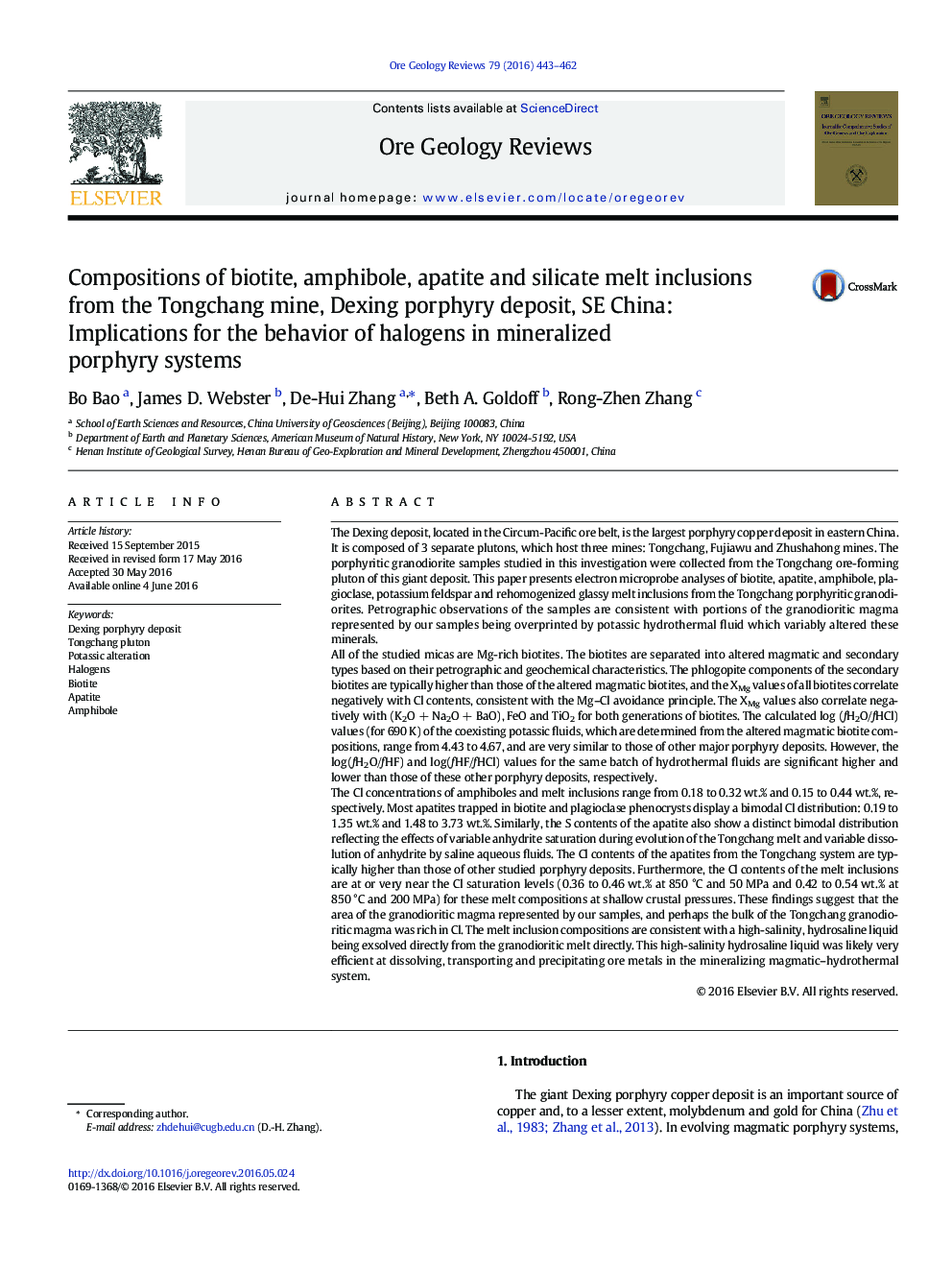| کد مقاله | کد نشریه | سال انتشار | مقاله انگلیسی | نسخه تمام متن |
|---|---|---|---|---|
| 4696808 | 1637227 | 2016 | 20 صفحه PDF | دانلود رایگان |

• Tongchang magmatic-hydrothermal system is Cl-rich and F-poor.
• Magmatic anhydrite saturation and dissolution form the bimodal distribution of S and Cl contents of the apatites.
• High Cl contents of the melt, calculated from the high-S and high-Cl apatites, match those in melt inclusions.
• Hydrosaline liquid, with or without vapor, may have exsolved directly from the late-stage Tongchang granodioritic magmas.
The Dexing deposit, located in the Circum-Pacific ore belt, is the largest porphyry copper deposit in eastern China. It is composed of 3 separate plutons, which host three mines: Tongchang, Fujiawu and Zhushahong mines. The porphyritic granodiorite samples studied in this investigation were collected from the Tongchang ore-forming pluton of this giant deposit. This paper presents electron microprobe analyses of biotite, apatite, amphibole, plagioclase, potassium feldspar and rehomogenized glassy melt inclusions from the Tongchang porphyritic granodiorites. Petrographic observations of the samples are consistent with portions of the granodioritic magma represented by our samples being overprinted by potassic hydrothermal fluid which variably altered these minerals.All of the studied micas are Mg-rich biotites. The biotites are separated into altered magmatic and secondary types based on their petrographic and geochemical characteristics. The phlogopite components of the secondary biotites are typically higher than those of the altered magmatic biotites, and the XMg values of all biotites correlate negatively with Cl contents, consistent with the Mg–Cl avoidance principle. The XMg values also correlate negatively with (K2O + Na2O + BaO), FeO and TiO2 for both generations of biotites. The calculated log (fH2O/fHCl) values (for 690 K) of the coexisting potassic fluids, which are determined from the altered magmatic biotite compositions, range from 4.43 to 4.67, and are very similar to those of other major porphyry deposits. However, the log(fH2O/fHF) and log(fHF/fHCl) values for the same batch of hydrothermal fluids are significant higher and lower than those of these other porphyry deposits, respectively.The Cl concentrations of amphiboles and melt inclusions range from 0.18 to 0.32 wt.% and 0.15 to 0.44 wt.%, respectively. Most apatites trapped in biotite and plagioclase phenocrysts display a bimodal Cl distribution: 0.19 to 1.35 wt.% and 1.48 to 3.73 wt.%. Similarly, the S contents of the apatite also show a distinct bimodal distribution reflecting the effects of variable anhydrite saturation during evolution of the Tongchang melt and variable dissolution of anhydrite by saline aqueous fluids. The Cl contents of the apatites from the Tongchang system are typically higher than those of other studied porphyry deposits. Furthermore, the Cl contents of the melt inclusions are at or very near the Cl saturation levels (0.36 to 0.46 wt.% at 850 °C and 50 MPa and 0.42 to 0.54 wt.% at 850 °C and 200 MPa) for these melt compositions at shallow crustal pressures. These findings suggest that the area of the granodioritic magma represented by our samples, and perhaps the bulk of the Tongchang granodioritic magma was rich in Cl. The melt inclusion compositions are consistent with a high-salinity, hydrosaline liquid being exsolved directly from the granodioritic melt directly. This high-salinity hydrosaline liquid was likely very efficient at dissolving, transporting and precipitating ore metals in the mineralizing magmatic–hydrothermal system.
Figure optionsDownload as PowerPoint slide
Journal: Ore Geology Reviews - Volume 79, December 2016, Pages 443–462